德莱拉的书架
文章都是转贴,为自己看起来方便, 谢谢各位作者了。- Apricot, peach, plum or nectarine jam.
- Apple jelly
- Apple butter
- Applesauce
- Blueberry Jam
- Fig Jam,
- Fig-strawberry jam,
- Grape jelly from fresh grapes
- Muscadine or scuppernong jelly
- Orange marmalade
- Peach butter
Ingredients and Equipment
- Fruit - preferably fresh, but frozen (without syrup works, too)
- Pectin (it'sa natural product, made from apples and available at grocery stores(season - spring through late summer) and in Wal-mart, grocery stores,etc. It usually goes for about $2.00 to $2.50 per box.See here for more information about how to choose the type of pectin to use.
- Jar funnel ($2 at WalMart, Target, and sometimes at grocery stores) or order it as part of the kit with the jar grabber.
- Sugar - About 4.5 cups of dry, granulated (table) sugar. For the no-sugar recipe, click here
- Jar grabber (to pick up the hot jars)- WalMart carries it sometimes- or order it here. It's a tremendously useful to put cars in thecanner and take the hot jars out (without scalding yourself!). The kitsold below has everything you need, and at a pretty good price:

- At least 1 large pot; I prefer 16 to 20 quart Teflon lined pots for easy cleanup.
- Large spoons and ladles
- 1 Canner(a huge pot to sterilize the jars after filling (about $30 to $35 atmall kitchen stores, sometimes at WalMart (seasonal item). Note: we sell canners and supplies here, too - at excellent prices - and it helps support this web site!
- Ball jars (Publix, WalMart carry then - about $7 per dozen 8 ounce jars including the lids and rings)
- Lids - thin, flat, round metal lids with a gum binder that seals them against the top of the jar. They may only be used once.
- Rings - metal bands that secure the lids to the jars. They may be reused many times.
Optional stuff:
- Foley Food Mill ($25) - not necessary; useful if you want to remove seeds (from blackberries) or make applesauce.
- Lid lifter(has a magnet to pick the lids out of the boiling water where yousterilize them. ($2 at WalMart or it comes in the kit at left)
Jam-making Directions
Thisexample shows you how to make either Strawberry jam or Strawberry -Raspberry - Blackberry Jam - also called Triple Berry Jam (my favorite,and everyone I give a jar to, says it has become their favorite, too!)But you can use this recipe to make any type of jam; where there is adifference, I will point it out! The yield from this recipe is about 8eight-ounce jars (which is the same as 4 pints).
Step 1 - Pick the berries! (or buy them already picked)
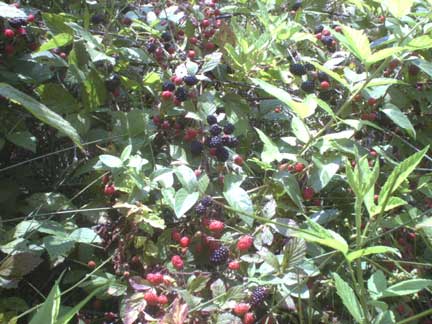
It's fun to go pick your own and you can obviously get better quality ones!
Atright is a picture I took of wild blackberries - they are plentiful inlate June throughout Georgia. I usually look in rural north Georgia.
I prefer to grow my own; which is really easy - but that does take some space and time.
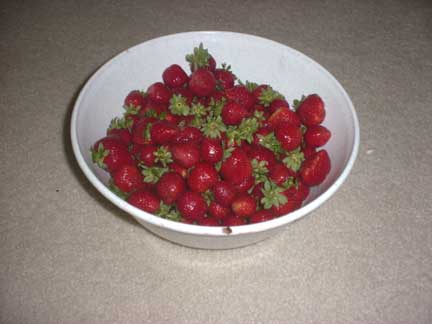 Asmentioned in the Ingredients section; you may use frozen berries (thosewithout syrup or added sugar); which is especially useful if you wantto make some jam in December to give away at Christmas!
Asmentioned in the Ingredients section; you may use frozen berries (thosewithout syrup or added sugar); which is especially useful if you wantto make some jam in December to give away at Christmas!Above andat left are strawberries and blackberries that I picked at apick-your-own farm. If you want to pick your own, here is a list andlinks to the pick your own farms.
How much fruit?
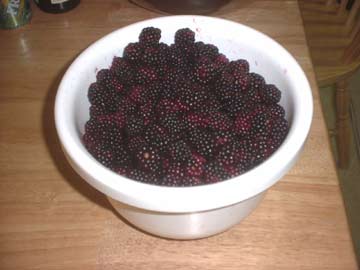 Jamcan ONLY be made in rather small batches - about 6 cups at a time -like the directions on the pectin say, DO NOT increase the recipes orthe jam won't "set" (jell, thicken). (WHY? Alton Brown on the FoodChannel says pectin can overcook easily and lose its thickeningproperties. It is easier and faster to get an even heat distributionin smaller batches. . It takes about 8 cups of raw, unprepared berriesper batch. For triple berry jam, I use 4 cups of mushed (slightlycrushed) strawberries, 1 cup of raspberries and 1 cup of blackberries.For strawberry-only jam; you’ll need 6 cups of mushed strawberries.
Jamcan ONLY be made in rather small batches - about 6 cups at a time -like the directions on the pectin say, DO NOT increase the recipes orthe jam won't "set" (jell, thicken). (WHY? Alton Brown on the FoodChannel says pectin can overcook easily and lose its thickeningproperties. It is easier and faster to get an even heat distributionin smaller batches. . It takes about 8 cups of raw, unprepared berriesper batch. For triple berry jam, I use 4 cups of mushed (slightlycrushed) strawberries, 1 cup of raspberries and 1 cup of blackberries.For strawberry-only jam; you’ll need 6 cups of mushed strawberries.Step 2 - Wash the jars and lids
 Now'sa good time to get the jars ready, so you won't be rushed later. Thedishwasher is fine for the jars, the water bath processing willsterilize them as well as the contents! If you don't have a dishwasher,you can wash the containers in hot, soapy water and rinse, thensterilize the jars by boiling them 10 minutes, and keep the jars in hotwater until they are used.
Now'sa good time to get the jars ready, so you won't be rushed later. Thedishwasher is fine for the jars, the water bath processing willsterilize them as well as the contents! If you don't have a dishwasher,you can wash the containers in hot, soapy water and rinse, thensterilize the jars by boiling them 10 minutes, and keep the jars in hotwater until they are used. NOTE: If unsterilized jars are used,the product should be processed for 5 more minutes. However, since thisadditional processing can result in a poor set (runny jam), it’s betterto sterilized the jars.
Put the lids into a pan of boiling waterfor 5 minutes, and use the magnetic "lid lifter wand" to pull themout. Leave the jars in the dishwasher on "heated dry" until you areready to use them. Keeping them hot will prevent the jars from breakingwhen you fill them with the hot jam.
Step 3 -Wash and hull the fruit!
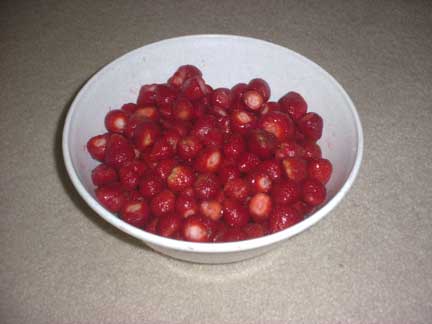 I'm sure you can figure out how to wash the fruit in plain cold water.
I'm sure you can figure out how to wash the fruit in plain cold water.With strawberries you must remove the hulls. With other berries, just pick off any stems and leaves.
Step 4 - Crush the fruit
Then you just mush them up a bit - not completely
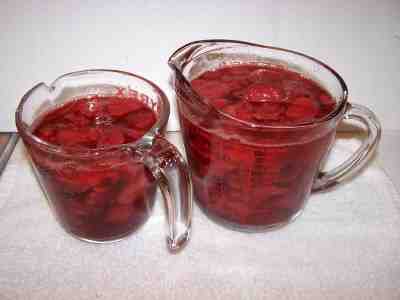 crushed,but mostly. Most people seem to like large chunks of fruit but crushingthem releases the natural pectin so it can thicken. You'll need about 6cups, mushed up.
crushed,but mostly. Most people seem to like large chunks of fruit but crushingthem releases the natural pectin so it can thicken. You'll need about 6cups, mushed up.If you want seedless jam, you may need to run the crushed berries through a Foley food mill (at right). They cost about $25.
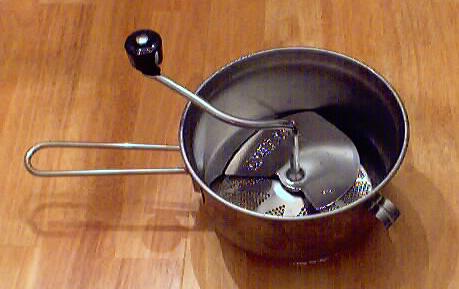
Itworks well for blackberries, not so well for raspberries, and no onetries to remove strawberry seeds (they're so small). I suppose youcould train monkeys to pick them out, but they'd probably form a tradelabor union. But I digress..
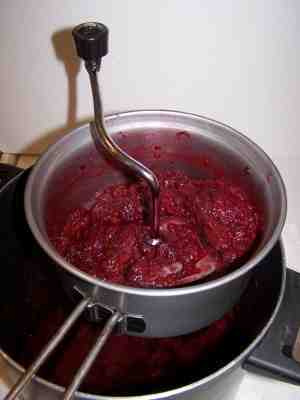
Step 5 - Measure out the sugar
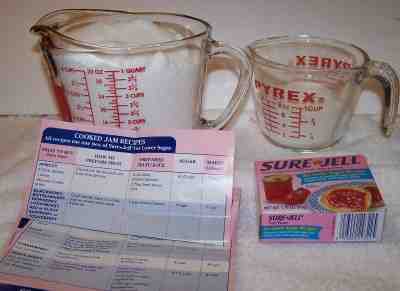 Dependingupon which type of jam you're making (strawberry, blackberry,raspberry, apricot, peach, grape, etc.) you will need to use adifferent amount of sugar, jam and pectin. The precise measurements arefound in each and every box of pectin sold. For most fruit; likeberries, with the low sugar pectin, you'll need 4 cups of sugar. Withregular pectin, about 7 cups of sugar. Mix the dry pectin with about1/4 cup of sugar and keep this separate from the rest of the sugar. This helps to keep the pectin from clumping up and allows it to mixbetter!
Dependingupon which type of jam you're making (strawberry, blackberry,raspberry, apricot, peach, grape, etc.) you will need to use adifferent amount of sugar, jam and pectin. The precise measurements arefound in each and every box of pectin sold. For most fruit; likeberries, with the low sugar pectin, you'll need 4 cups of sugar. Withregular pectin, about 7 cups of sugar. Mix the dry pectin with about1/4 cup of sugar and keep this separate from the rest of the sugar. This helps to keep the pectin from clumping up and allows it to mixbetter!If you would rather try to make jam with no added sugar, click here for those directions!
Step 6 - Mix the berries with the pectin and cook to a full boil
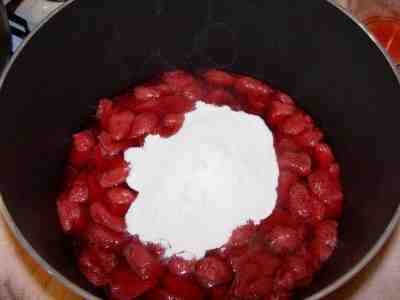 Stirthe pectin into the berries and put the mix in a big pot on the stoveover medium to high heat (stir often enough to prevent burning). Itshould take about 5 to 10 minutes to get it to a full boil (the kindthat can not be stirred away).
Stirthe pectin into the berries and put the mix in a big pot on the stoveover medium to high heat (stir often enough to prevent burning). Itshould take about 5 to 10 minutes to get it to a full boil (the kindthat can not be stirred away).Why use pectin? You may run into grandmotherly types who sniff "Inever used pectin!" at you. Well, sure, and their generation took ahorse and buggy to work, died of smallpox and ate canned meat and greenbeans that tastes like wet newspapers. Old fashioned ways are notalways better nor healthier. Pectin, which occurs naturally in fruit,is what makes the jam "set" or thicken. The pectin you buy is justnatural apple pectin, more concentrated. Using pectin dramaticallyreduces the cooking time, which helps to preserve the vitamins andflavor of the fruit, and uses much less added sugar. But, hey, if youwant to stand there and stir for hours, cooking the flavor away, who amI to stop you! :) We can probably find an old foot-pedal operateddrill for the dentist to use when he fixes the cavities in your teethfrom the extra sugar you'll need to add, too...
Notes about pectin:I usually add about 20% more pectin (just open another pack and add alittle) or else the jam is runnier than I like. With a little practice,you'll find out exactly how much pectin to get the thickness you like.
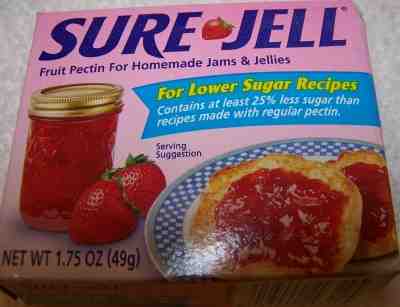
Anothertip: use the lower sugar or no-sugar pectin. You can add sugar toeither and it cuts the amount of sugar you need from 7 cups per batchto 4 cups or less! And it tastes even better! On the other hand; I havenever had success with the No-sugar pectin without adding ANY sugar. Italways turned out runny and bland. You might want to try using the lowsugar or no-sugar recipe with a mixture of sugar and Splenda; sugar andwhite grape juice, or just white grape juice - that will cut down thesugar, but still preserve the flavor.

Isyour jam too runny? Pectin enables you to turn out perfectly set jamevery time. Made from natural apples, there are also low-sugar pectinsthat allow you to reduce the sugar you add by almost half!
Get it here at BETTER prices!Step 7 - Get the lids sterilizing
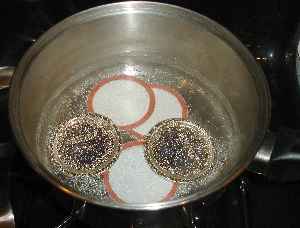 Lids: put the lids into a pan of hot water for at least several minutes; to soften up the gummed surface and clean the lids.
Lids: put the lids into a pan of hot water for at least several minutes; to soften up the gummed surface and clean the lids.Need lids, rings and replacement jars?
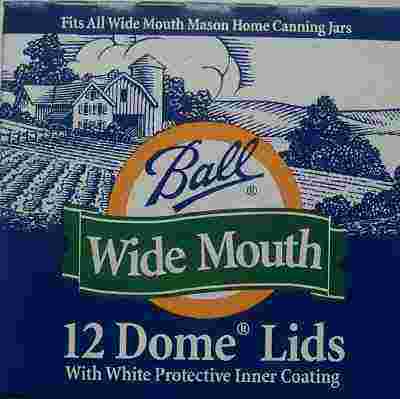

 Get them all here, delivered direct to your home, at the best prices on the internet!
Get them all here, delivered direct to your home, at the best prices on the internet!Step 8 - Add the remaining sugar and bring to a boil again for 1 minute
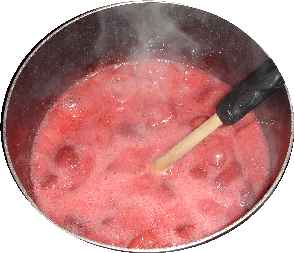
Whenthe berry-pectin mix has reached a full boil, add the rest of the sugar(about 4 cups of sugar per 6 cup batch of berries) and then bring itback to a boil and boil hard for 1 minute...
Remove from the heat.
Step 9 - Skim any excessive foam
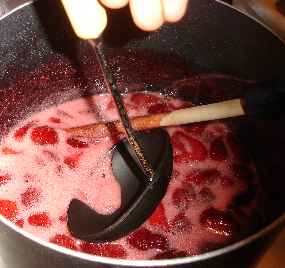 Foam... What is it? Just jam with a lot of air from the boiling.
Foam... What is it? Just jam with a lot of air from the boiling.  But it tastes more like, well, foam, that jam, so most people removeit. It is harmless, though. Some people add 1 teaspoon of butter ormargarine to the mix in step 6 to reduce foaming, but food expertsdebate whether that may contribute to earlier spoilage, so I usuallyomit it and skim.
But it tastes more like, well, foam, that jam, so most people removeit. It is harmless, though. Some people add 1 teaspoon of butter ormargarine to the mix in step 6 to reduce foaming, but food expertsdebate whether that may contribute to earlier spoilage, so I usuallyomit it and skim.But save the skimmed foam! You can recover jam from it to use fresh! See this page for directions!
Step 10 - Testing for "jell" (thickness)
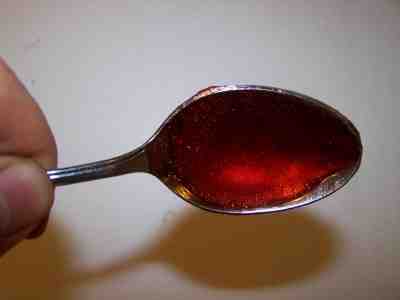 Ikeep a metal tablespoon sitting in a glass of ice water, then take ahalf spoonful of the mix and let it cool to room temperature on thespoon. If it thickens up to the consistency I like, then I know the jamis ready. If not, I mix in a little more pectin (about 1/4 to 1/2 ofanother package) and bring it to a boil again for 1 minute.
Ikeep a metal tablespoon sitting in a glass of ice water, then take ahalf spoonful of the mix and let it cool to room temperature on thespoon. If it thickens up to the consistency I like, then I know the jamis ready. If not, I mix in a little more pectin (about 1/4 to 1/2 ofanother package) and bring it to a boil again for 1 minute.Notes about "set" (thickening or jell):It takes 3 ingredients for jams and jellies to set: pectin, sugar andacidity. The amount of pectin that is naturally occurring in the fruitvaries from one type of fruit to another and by ripeness (counterintuitively, unripe contains more pectin). See this pagefor more about pectin in fruit. It takes the right balance, andsufficient amounts of each of pectin, sugar and acidity to result in afirm jam or jelly. Lastly, it takes a brief period (1 minute) of a hardboil, to provide enough heat to bring the three together. Generallyspeaking, if your jam doesn't firm up, you were short in pectin, sugaror acidity or didn't get a hard boil. That's ok - you can "remake' thejam; see this page!
Step 11 - Optional: Let stand for 5 minutes and stir completely.
Why?Otherwise, the fruit will often float to the top of the jar. This isn'ta particular problem; you can always stir the jars later when you openthem; but some people get fussy about everything being "just so", soI've included this step! Skipping this step won't affect the quality ofthe jam at all. I usually don't bother.
You’ll also notice thatthe less sugar you use, the more the fruit will float (chemists willtell you it is due to the decreased density of the solution!)
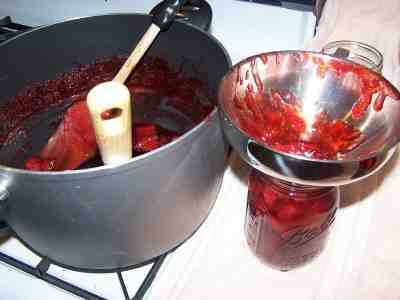 Step 12 - Fill the jars and put the lid and rings on
Step 12 - Fill the jars and put the lid and rings on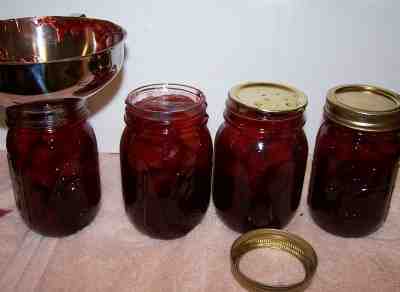 Fillthem to within 1/4 inch of the top, wipe any spilled jam off the top,seat the lid and tighten the ring around them. Then put them into theboiling water canner!
Fillthem to within 1/4 inch of the top, wipe any spilled jam off the top,seat the lid and tighten the ring around them. Then put them into theboiling water canner!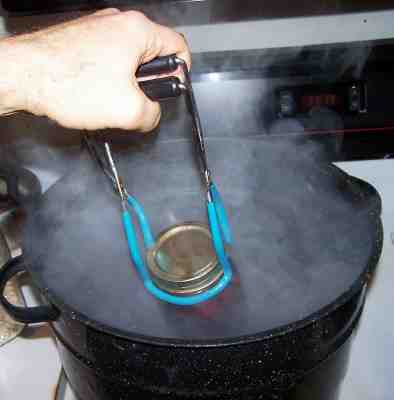
This is where the jar tongs come in really handy!
Step 13 - Process the jars in the boiling water bath
Keepthe jars covered with at least 1 inch of water. Keep the water boiling.In general, boil them for 10 minutes, which is what SureJell (themakers of the pectin) recommend. I say "in general" because you haveto
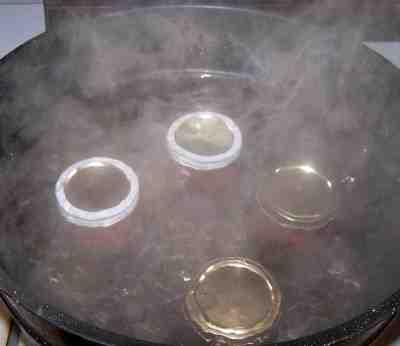 process(boil) them longer at higher altitudes than sea level, or if you uselarger jars, or if you did not sterilize the jars and lids right beforeusing them. The directions inside every box of pectin will tell youexactly. The directions on the pectin tend to be pretty conservative. Clemson University says you only need to process them for 5 minutes. Iusually hedge my bets and start pulling them out after 5 minutes, andthe last jars were probably in for 10. I rarely have a jar spoil, soit must work. But you don't want to process them too long, or the jamwill turn dark and get runny. See the chart below for altitudeadjustment to processing times, if you are not in the sea level to1,000ft above sea level range.
process(boil) them longer at higher altitudes than sea level, or if you uselarger jars, or if you did not sterilize the jars and lids right beforeusing them. The directions inside every box of pectin will tell youexactly. The directions on the pectin tend to be pretty conservative. Clemson University says you only need to process them for 5 minutes. Iusually hedge my bets and start pulling them out after 5 minutes, andthe last jars were probably in for 10. I rarely have a jar spoil, soit must work. But you don't want to process them too long, or the jamwill turn dark and get runny. See the chart below for altitudeadjustment to processing times, if you are not in the sea level to1,000ft above sea level range.Note: Some people don't even boilthe jars; they just ladle it hot into hot jars, put the lids and ringson and invert them, but putting the jars in the boiling water bathREALLY helps to reduce spoilage! To me, it makes little sense to putall the working into making the jam and then not to process the jars tobe sure they don't spoil!
Recommended process time for jams in a boiling water canner.
Process Time at Altitudes of Style of Pack Jar Size 0 - 1,000 ft 1,001 - 6,000 ft Above 6,000 ft Hot Half-pints
or Pints5 min 10 15 Step 14 - Remove and cool the jars - Done!
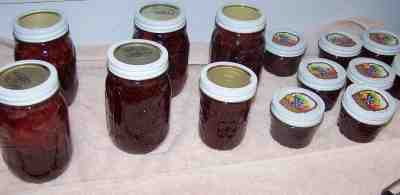 Liftthe jars out of the water with your jar lifter tongs and let them coolwithout touching or bumping them in a draft-free place (usually takesovernight) You can then remove the rings if you like.
Liftthe jars out of the water with your jar lifter tongs and let them coolwithout touching or bumping them in a draft-free place (usually takesovernight) You can then remove the rings if you like. Oncecooled, they're ready to store. I find they last up to 12 months. Butafter about 6 to 8 months, they get darker in color and start to getrunny. They still are safe to eat, but the flavor and texture aren't asgood. So eat them in the first 6 months after you prepare them! Another trick is to keep the uncooked berries or other fruit in thefreezer and make and can the jam as needed, so it's always fresh.
----------------------------------------------------------
更多的配方:
http://www.inmamaskitchen.com/FOOD_IS_ART_II/food_history_and_facts/jam_sauce_making.html
jam and Sauce Recipes:- apple-pear preserves - this is slightly spicy
- brandied apricot jam
- gingered apricot sauce
- apricot jam - thick with fruit, a luscious jam
- apricot jam with a twist- make apricot jam with dried apricots when fresh are not in season
- blueberry - Jamlady's blueberries in snow
- chicken balls with apricot sauce
- berry jam - covers all the berries, mixed or alone
- corn cob jelly - everything can be made from corn
- fig jam -to have summer's freshness in winter
- lemon chutney - for grilled dishes
- tomato sauce preserves - a sauce, but also a preserve
- quince marmalade - this may be the original marmalade
- freezer strawberry jam - no need to sterilize bottles when it goes in the freezer
- plum and blueberry jam with a zing
- plum and chili sauce
- tomato - hot tomato jam or 'hot burger' jam' - from the Jamlady Cookbook
------------------------------------------------------------------------------------------------
We have 19,533 Recipes in 41 Categories:
http://www.justfruitrecipes.com/




